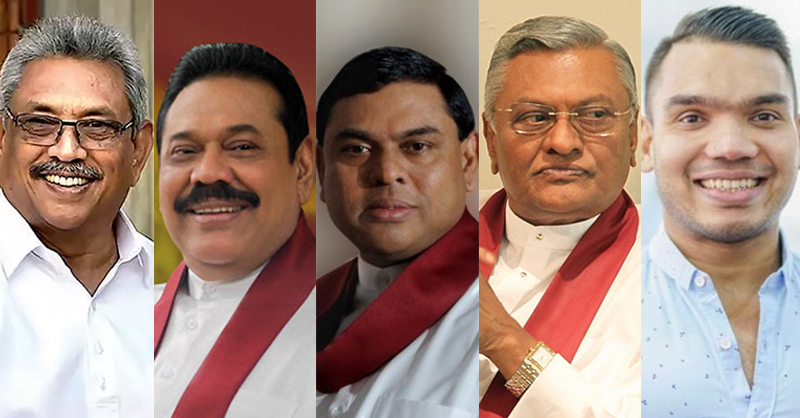-By LeN Financial Correspondent

(Lanka-e-News -26.July.2025, 9.45 PM) A sweeping international financial investigation is currently underway into what experts now describe as one of the largest peacetime public finance heists in Asia: the alleged theft of more than US$7 billion by Sri Lanka’s Rajapaksa political dynasty over a 15-year period.
The sum—equivalent to nearly a quarter of Sri Lanka’s annual GDP—was allegedly extracted from public funds, foreign investment inflows, and procurement deals during two separate Rajapaksa-led governments, spanning from 2005 to 2015 and again from 2019 to mid-2022, until then-President Gotabaya Rajapaksa fled the country amidst a mass uprising.
Investigators with knowledge of the case suggest the looted funds were siphoned through inflated military procurements during the civil war, questionable road construction tenders, government healthcare supply chains, housing schemes such as the Maganeguma rural infrastructure programme, and politically connected ministries including fisheries, aviation, and finance.
But perhaps most troubling are allegations of money laundering through Sri Lanka’s once-proud flag carrier, SriLankan Airlines, after its controversial withdrawal from the Emirates partnership—a move critics claim was motivated more by personal and political interests than national strategy.
Financial trail analysis shows that significant portions of the $7 billion have been laundered into tourism ventures, shipping and logistics firms, high-end real estate portfolios across 18 countries, and a constellation of shell companies that specialize in vehicle importation and plantation agriculture. One such entity, sources allege, operates under the guise of a prominent leasing company in Sri Lanka—identified in whispers as “Browns,” not in reference to colour, but to a complex investment structure used to park illicit wealth.
A former senior official at the Central Bank of Sri Lanka, speaking under condition of anonymity, described the Rajapaksa-era financial flows as “an organised system of domestic and cross-border money diversion, involving politically sanctioned corruption on a systemic scale.”
“These funds were not just stolen—they were actively embedded into sectors where recovery becomes almost impossible without political will and global coordination,” he added.
Preliminary findings by a multi-jurisdictional task force—comprising forensic accountants, AML (anti-money laundering) experts, and legal advisors based in London, Geneva, and Dubai—have unearthed a sprawling financial network tied to family proxies, offshore trusts, and nominee accounts. The assets include:
• Hotel chains in Southeast Asia and the Middle East
• Shell companies owning commercial property in Australia, Canada, and the UK
• Fronts in Cyprus and the British Virgin Islands
• Undeclared stakes in Dubai-based aviation service providers and ship leasing firms
Moreover, businesses involved in sugar imports, private leasing, banking, and agribusiness are now being scrutinised for receiving capital linked to Rajapaksa interests. Under new asset recovery legislation passed in Colombo earlier this year, any individual or corporate entity found to have profited from embezzled public funds could be subject to seizure, recovery litigation, and criminal prosecution.
Sri Lanka’s newly appointed Asset Recovery Commission (ARC)—backed by the United Nations Office on Drugs and Crime (UNODC) and Interpol’s financial crimes unit—has begun tracing illicit flows through SWIFT transaction data, corporate registries, and cross-border fund transfers. A confidential report viewed by the Financial Times outlines an aggressive roadmap for litigation against overseas property holdings linked to Rajapaksa relatives and known business associates.
“The idea is not just prosecution, but repatriation,” said a Colombo-based official close to the ARC. “Sri Lankan taxpayers need their money returned, and that will not happen without serious cooperation from foreign jurisdictions.”
Already, forensic audits have flagged suspicious transactions in commercial banks based in Dubai, Kuala Lumpur, and Zurich, many of which mirror methods used in previous high-profile kleptocracy cases from Nigeria and Malaysia.
Efforts to recover the stolen assets, however, face significant domestic resistance. Senior figures in Sri Lanka’s bureaucracy and financial sector—some of whom remain Rajapaksa loyalists—have been accused of stonewalling investigations and destroying evidence.
One such case involves documents related to military procurement between 2006 and 2009, which were reportedly erased or removed from the Ministry of Defence digital archives days before Gotabaya Rajapaksa resigned in July 2022.
There are also allegations that influential media owners and conglomerates who benefitted from Rajapaksa-era advertising budgets are attempting to derail public discourse on the issue by downplaying its scale.
Perhaps the most controversial name surfacing in the probe is that of a sprawling corporate entity often referred to in coded terms as “Browns.” This enterprise—originally known for its presence in agriculture and manufacturing—has in recent years grown rapidly in vehicle leasing, commercial shipping, and plantations, with several of its subsidiaries linked to opaque financing arrangements that align with the movement of illicit funds.
“There is no smoking gun—yet,” said an international legal analyst familiar with the case. “But many of these entities show classic red flags of politically exposed person (PEP) enrichment: rapid unexplained growth, no viable debt structure, and cross-border capital flows unaligned with declared earnings.”
If proven, these links could expose a vast undercurrent of Rajapaksa wealth entrenchment in Sri Lanka’s private sector, making asset recovery even more politically sensitive.
With international momentum building, the question is no longer whether the money was stolen—but whether Sri Lanka’s political leadership has the resolve to recover it.
For decades, the Rajapaksas were revered by some as war heroes and builders of infrastructure. But a new generation of Sri Lankans, burdened by economic collapse, debt, and austerity, now view the family’s legacy through a darker lens—one of entrenched corruption, chronic mismanagement, and a billion-dollar betrayal.
As the ARC prepares to file its first set of claims in international courts, all eyes will be on the ability of this small island nation to claw back what was taken—and restore some measure of justice to its embattled public finances.
---------------------------
by (2025-07-26 16:20:26)
Leave a Reply